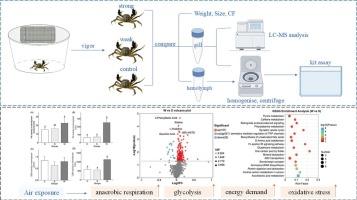不同耐受性中华绒螯蟹幼体的行为反应、呼吸代谢相关酶活性和代谢组学比较
IF 1.8
3区 生物学
Q4 BIOCHEMISTRY & MOLECULAR BIOLOGY
Comparative Biochemistry and Physiology B-Biochemistry & Molecular Biology
Pub Date : 2024-10-18
DOI:10.1016/j.cbpb.2024.111040
引用次数: 0
摘要
空气暴露是中华绒螯蟹在饲养和运输过程中常见的应激源,空气暴露耐受性可作为评估中华绒螯蟹幼体质量的重要指标。本研究根据中华绒螯蟹幼体的行为反应将其分为两组:S组对空气暴露的耐受性强,W组耐受性弱。未暴露于空气中的浸泡蟹作为对照组(C组)。比较了三组螃蟹的全身形态特征以及血淋巴和前鳃中与呼吸代谢有关的酶活性。对前鳃进行了非靶向 LC-MS 代谢组学分析。结果表明,与发育阶段无关,体型较大、条件因子较高的蟹对空气暴露的耐受性更强。此外,与W组相比,空气暴露对S组血淋巴和前鳃的糖酵解和无氧呼吸代谢过程的影响相对较小。与此同时,暴露在空气中会诱发血淋巴和前鳃的氧化应激。这项研究加深了我们对中华绒螯藻暴露于空气中的反应机制的理解,为鉴定优质中华绒螯藻幼体提供了理论参考。本文章由计算机程序翻译,如有差异,请以英文原文为准。

Comparison of behavioral responses, respiratory metabolism-related enzyme activities, and metabolomics of the juvenile Chinese mitten crab Eriocheir sinensis with different tolerance to air exposure
Air exposure is a common stressor for Chinese mitten crab (Eriocheir sinensis) during rearing and transport, and air exposure tolerance can serve as a crucial indicator for assessing the quality of juvenile E. sinensis. In this study, juvenile E. sinensis were divided into two groups based on their behavioral responses: Group S, which exhibited strong tolerance to air exposure, and Group W, which exhibited weak tolerance. Immersed crabs, not exposed to air, served as a control group (Group C). Whole body morphological characteristics and enzyme activities related to respiratory metabolism in the hemolymph and anterior gills were compared among the three groups. Non-targeted LC-MS metabolomic analysis was conducted on anterior gills. The results showed that, independent of developmental stage, crabs that were larger and had higher condition factor were more tolerant to air exposure. Additionally, compared to Group W, air exposure had a relatively small effect on glycolysis and anaerobic respiratory metabolic processes in the hemolymph and anterior gills of Group S. In response to air exposure, E. sinensis experienced increased energy demand, and switched from aerobic to anaerobic respiration to increase energy supply. Simultaneously, air exposure induced oxidative stress in the hemolymph and anterior gills. This study enhances our understanding of the response mechanism of E. sinensis to air exposure and provides a theoretical reference for the identification of high-quality juvenile E. sinensis.
求助全文
通过发布文献求助,成功后即可免费获取论文全文。
去求助
来源期刊
CiteScore
4.60
自引率
4.50%
发文量
77
审稿时长
22 days
期刊介绍:
Comparative Biochemistry & Physiology (CBP) publishes papers in comparative, environmental and evolutionary physiology.
Part B: Biochemical and Molecular Biology (CBPB), focuses on biochemical physiology, primarily bioenergetics/energy metabolism, cell biology, cellular stress responses, enzymology, intermediary metabolism, macromolecular structure and function, gene regulation, evolutionary genetics. Most studies focus on biochemical or molecular analyses that have clear ramifications for physiological processes.

 求助内容:
求助内容: 应助结果提醒方式:
应助结果提醒方式:


